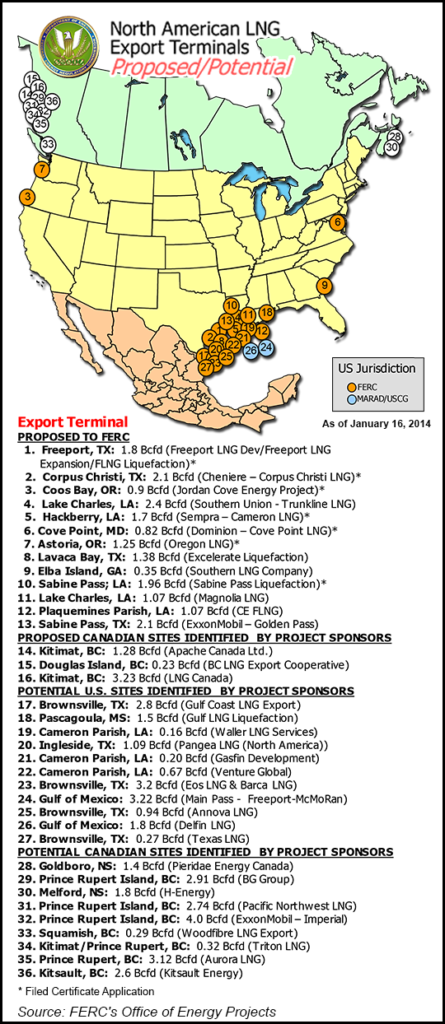Regulatory | Infrastructure | LNG | NGI All News Access | NGI The Weekly Gas Market Report
FERC’s LaFleur Hopes to ‘Make Progress’ on LNG Export Applications in 2014
Noting that liquefied natural gas (LNG) export terminals are “significant facilities” with applications that require extensive reviews, Acting FERC Chairman Cheryl LaFleur said the Commission would try to act on project proposals “as quickly as we can.”

“We have 13 cases pending right now,” she told a roundtable of journalists on Monday. “Some are existing facilities that were built to import LNG that are flipping around. Others are greenfield sites where they are building fresh. We conduct a thorough environmental and safety review, including getting input from other agencies. We’ve had one that we’ve approved; the Cheniere project down in Louisiana, and there are several more that are either in pre-permitting or the permitting stage.”
The Department of Energy (DOE) has authorized permits for four projects to export LNG to countries without free trade agreements, but only one, Cheniere Energy’s Sabine Pass Liquefaction LLC and Sabine Pass LNG LP, has received site and facilities approval from the Federal Energy Regulatory Commission (FERC) and is now under construction (see Daily GPI, April 17, 2012).
LaFleur, who defended FERC’s application review method in December during a hearing of the House Subcommittee on Energy and Power (see Daily GPI, Dec. 5, 2013), once again stood up for the Commission’s process.
She acknowledged that the 13 projects are not in a queue, but are all being reviewed simultaneously on the different stages they are in. As for how many reviews would be completed this year, LaFleur said, “I would certainly hope we make progress in 2014.”
Earlier this month, Peter Hansen, CEO of the proposed Oregon LNG project slated for a site at Warrenton, OR (see Daily GPI, April 25, 2012), claimed that bureaucratic indecision and squabbling surrounding some parts of LNG export facilities were holding up the processing of FERC applications (see Daily GPI, Jan. 2).
“The largest office of FERC is the Office of Energy Projects, so we have adequate staff to handle all of the projects…,” LaFleur said. “These are significant facilities that require careful environmental and safety reviews, and that is what we are doing. I hope we’re not a bottleneck. We can only try to get them out as quickly as we can, but we are sensitive to industry concerns, so we redouble our efforts to get it done as effectively as we can.”
As it currently stands, the DOE is in charge of reviewing the export of the actual commodity, while FERC is responsible for reviewing the environmental and safety aspects of the export terminal proposals. “Any additional authority that Congress wants to give us, we would endeavor to do a good job with,” LaFleur said. “I think the work that DOE does is fundamentally different. They are looking at global energy trends and balance of trades, and we’re looking at more the facility permitting. So those are really two different types of reviews.”
© 2024 Natural Gas Intelligence. All rights reserved.
ISSN © 1532-1231 | ISSN © 2577-9877 | ISSN © 1532-1266 |
